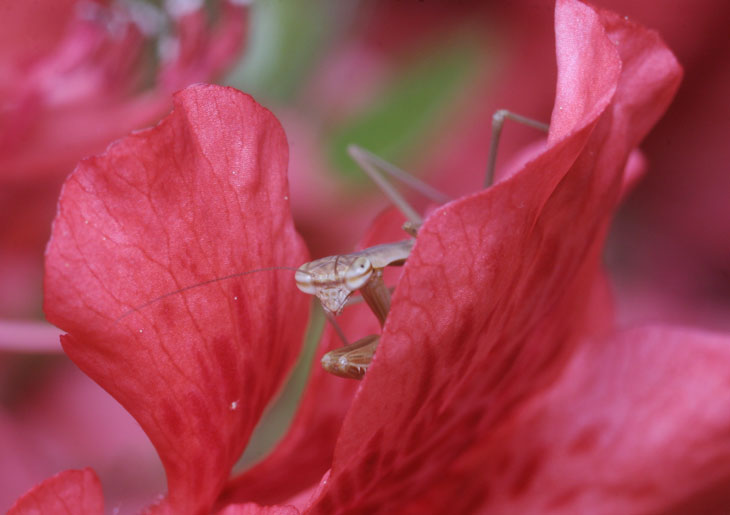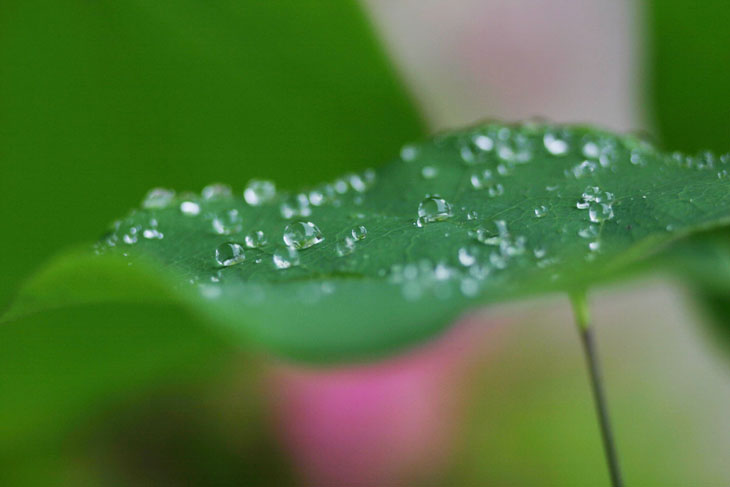
The past few days have been overcast and either rainy or misty, so photo opportunities were a little limited, but the azaleas are in full bloom so they’re providing much better settings for the mantis images now. I remain unsure how old the mantises were when I found them – I’m guessing at least a few days, since their eyes had changed from the dark ones I’ve seen on newly-hatched specimens to having some camouflaging color. I’m also unsure if they need to molt to accomplish that, like most other color changes, but it’s clear that they’ve molted since then, because their coloration is more green and they’re noticeably bigger now, though still tiny. They’re also slightly more complacent, though still not thrilled about my presence, but this means I can do a little more towards creative compositions and something a bit expressive. I’m trying to take advantage of this now, since the blooms will soon turn into crumpled brown petals everywhere and achieving a nice setting will be that much harder.

I’ve been trying out a new lighting system, and so far have been pleased with it. I’ve had an old Sunpak FP38 flat panel flash for a while now, but it saw little use because it was hard to get the right angle. Wide, diffuse, or ‘softboxed’ lighting should largely be over the subject, providing light from a natural angle and giving more shaping and dimension than a straight-on flash provides. The mounting system for the flash is the typical setup though, a standard shoe-mount, which places it high above the centerline of the camera, or high above wherever the flash bracket can hold it. It’s not huge, but big enough to produce a lot of leverage when tilted, hard on both whatever tilting mechanism can be used, and the hand holding the rig (which includes camera, macro lens, and bracket.) I altered this by adding an angled reflector/extension to the front, made from matboard and diffusing cloth, and it’s been working pretty well. I’ll try to feature it in detail later on.
 On the vines along the fence, I spotted a jumping spider, probably a Hentzia mitrata, ducking under a leaf. That’s simply not acceptable to arthropod photographers, so I snaked a finger underneath and flushed it out. Normally such a display of shyness means good pics could be taxing, since the looming camera is enough to chase the subject back into hiding, but this little guy took it as a challenge. For reasons unknown, he (yes, it’s a male) started stalking me in return, constantly working closer by jumping and scrambling across the leaves; he even stopped twice and attempted to throw a webline into the wind to cross a particularly daunting chasm (when you’re about 4mm in length, this is relative.) The distance I had to maintain for sharp focus meant he never drew close enough to actually leap onto the camera, and I eventually left him extended out on the end of a tendril vine, perhaps frustrated. Who knows what emotions, or their analogs, arachnids feel? And yes, that’s a mist drop atop the cephalothorax.
On the vines along the fence, I spotted a jumping spider, probably a Hentzia mitrata, ducking under a leaf. That’s simply not acceptable to arthropod photographers, so I snaked a finger underneath and flushed it out. Normally such a display of shyness means good pics could be taxing, since the looming camera is enough to chase the subject back into hiding, but this little guy took it as a challenge. For reasons unknown, he (yes, it’s a male) started stalking me in return, constantly working closer by jumping and scrambling across the leaves; he even stopped twice and attempted to throw a webline into the wind to cross a particularly daunting chasm (when you’re about 4mm in length, this is relative.) The distance I had to maintain for sharp focus meant he never drew close enough to actually leap onto the camera, and I eventually left him extended out on the end of a tendril vine, perhaps frustrated. Who knows what emotions, or their analogs, arachnids feel? And yes, that’s a mist drop atop the cephalothorax.
The bad thing about the flat panel flash is how quickly it burns through batteries – I have yet to convert it to an external powerpack. So when the batteries died during some abstract shots, I switched to a wide-open aperture and used natural light for the following image. It had to be lightened considerably in post-processing (that’s one of those terms left over from film,) which contributed to the grainy appearance, but I think that adds a little more atmosphere to it.




















































